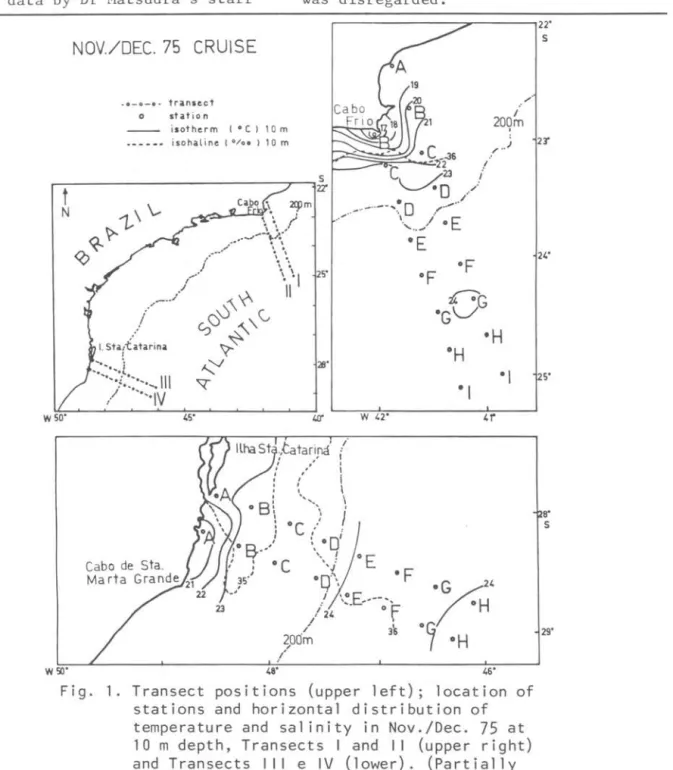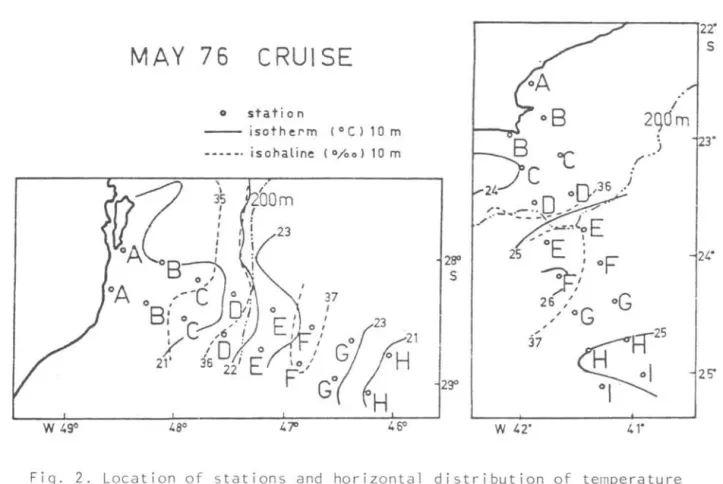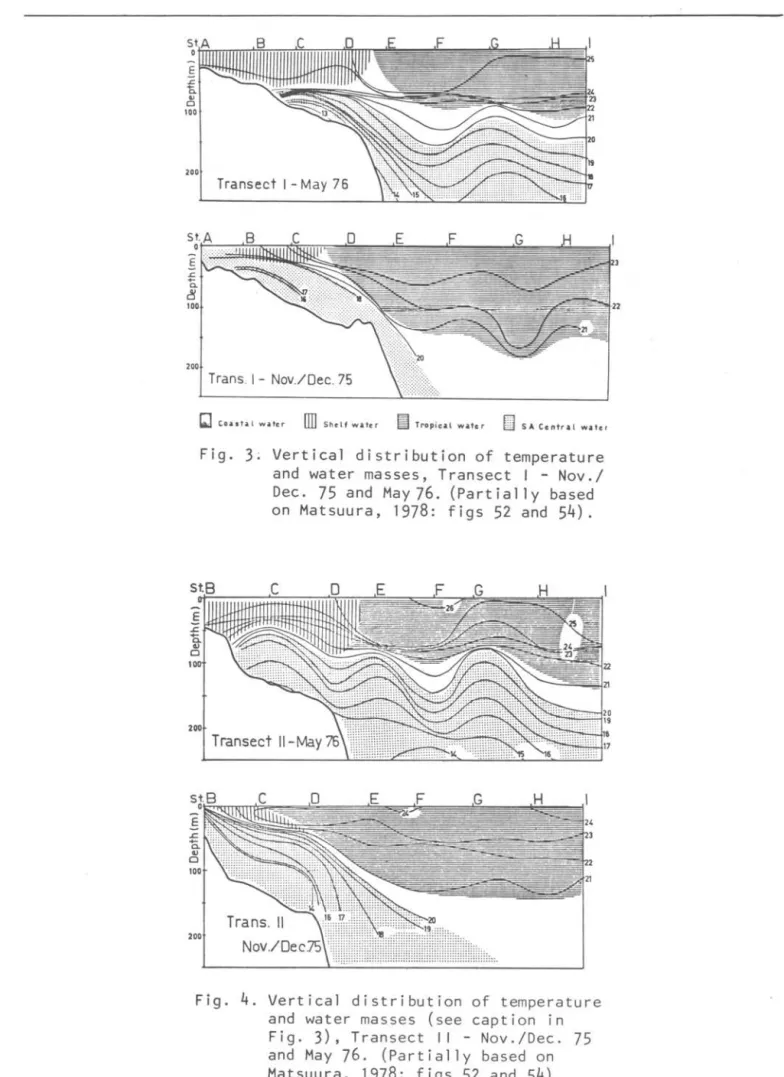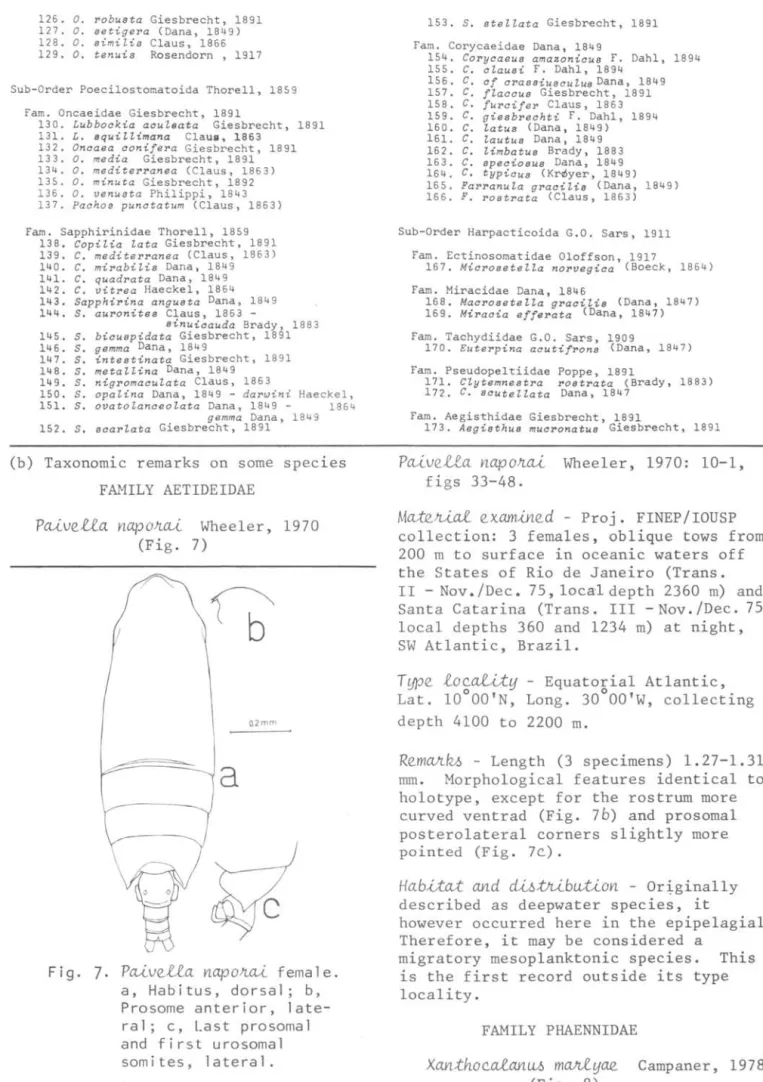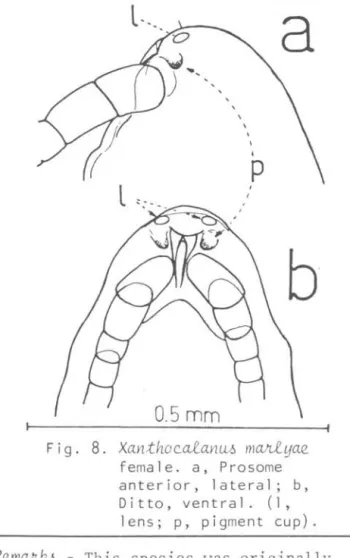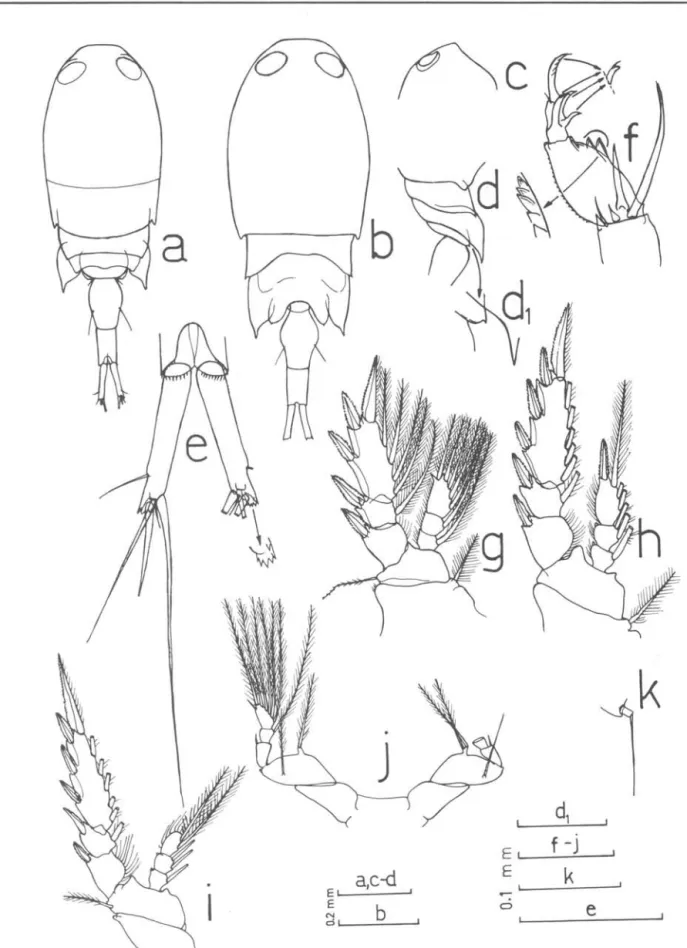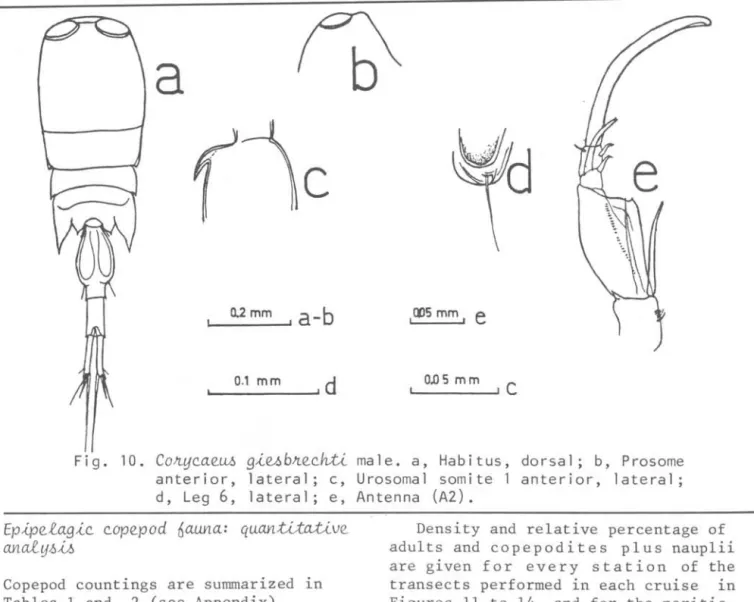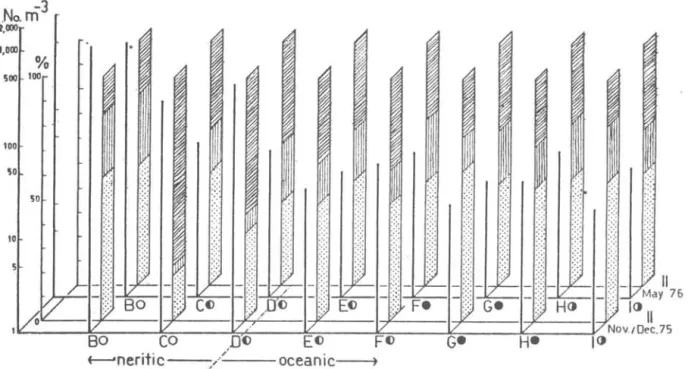Bol m Inst. ocea/nogr., S Paulo, 33(1):5-27,
1985
OCCURRENCE AND DISTRIBUTION OF COPEPODS (CRUSTACEA) IN THE EPIPELAGIAL
OFF SOUTHERN BRAZIL*
Antonio Frederico CAMPANER
Instituto de
Bio
c i~ncias
da Universidade de sio Paulo
**
Synopsis
The copepods of plankton samples collected with a Bongo net of 0.333 mm mesh in 66
oceanographic stations of
4
transects off the States of Rio de Janeiro (RJJ
and
Santa Catarina (SC J in Nov . /Dec .
75
and May
76
were qualitatively and quantitatively
studied .
An amount of
173
species was
identified
~
of 7Jhich
P~v~lta
napo~~
Wheeler ~ Xantho~alan~ m~y~ Campaner ~
and
C o~ y~a ~ ~ gie~b~~htiF. Dahl were
taxonomically reviewed.
Frequency and density of each
species ~and absolute and
mean density of total copepods were determined for every
station ~as well as
frequency of adult females and
males ~and young forms . Abundance was higher in the
neritic than in the oceanic zone, the mean density being twice greater of the
neritic zone of RJ tlzan in that of SC, and almost identical in the oceanic zone
off both States except for SC in Nov . /Dec .
75 ~where values were thrice greater
than in RJ . These results were related to the distribution of water masses in the
sampling areas .
Copepod associations were determined for neritic and oceanic
zones off the States of RJ and
sc
at both sampling seasons.
Descriptors: Crustacea, Copepoda, Abundance, Ecological distribution, Animal
mor-phology, Community composition, Plankton, Check 1 ist, Taxonomy,
Population density, Water masses, Oceanic province, Neritic province,
Assoc i at i ons (eco 1 og i ca 1),
Pa.{v ~lta napo~~, Xantho~alanu~ m~ya~.Co~y~ae . ~ gie~b~~hti,
Rio de Janeiro, Santa Catarina, SW Atlantic.
Descritores: Crustacea, Copepoda, Abundância, Distribuição ecológica, Morfologia
animal, Composição da comunidade, Plâncton, Lista de espécies,
Taxo-nomia, Densidade da população, Massas de água, Província oceânica,
Província nerítica, Associa ções ecológicas,
P~v~tta napo~~,Xantho-~alCU1U~ mMtlja~ , CO~ljc.a~u~ 9'{~~b~~~ht.{ ,
Rio de Janeiro, Santa Cat a rina,
Atlântico Sul Ocidental.
Introduction
The marine planktonic copepods from the
South Atlantic off Brazil have been
télxonomically and eco l ogically surveyed
since the end of last century from
material collected by foreign
oceanographic expeditions . A general
study of the distribution of these
animals related to water masses was
made by Rjornberg
(1963).
Con t emporary
and latter surveys (mainly Gaudy,
1963 ;
Bjornberg,
1965, 1981)
have not only
enlarged our knowledge about th e
epipe l agic species, but also contribut ed
other data on the deepwater fauna .
*
From part of a project supported by
"Financiadora de Estudos e Projetos
-FINEP".
**
Departamento de Zoologia, Instituto de
Biociências, USP - CP
20520, 01000
-sio Paulo, Brasil.
Pubi. n.
612
do
In~t. o~~anog~.da
U~p.From
1975
to
1979,
the R/V "ProL
W. Besnard " of th e University of são
Paulo made seven research cruises off
sou t hern Brazil. The firs t results
about copepod surveys based on the
plankton samples collec t ed have been
recently publi shed (Campaner,
1981).
The qualitative and quantitative copepod
composi ti on in neritic a nd oceanic zones
off th e States of Rio de Janeiro and
Santa Ca t a rina during Nov . /Dec.
75
and May
76
is s tudi ed here, together wi th the
probable seasonal influence of the
distribution of wa t er masses.
Material and lIlethods
6
Bolm Inst. oceanogr., S Paulo, 33(1),1985
one in May 76 (Figs 1-2). Temperature
(Instituto Oceanográfico USP), and
kindly put at my disposal.
and salinity data were obtained at surface,
10 m, and bottom in all stations, and
temperature profiles were recorded by a
bathythermograph.
Plankton samples were collected with
two Bongo nets with 61 cm mouth diameter,
300 cm length and, respectively, 0.505
mm and 0.333 mm mesh, and preserved in
10% formaldehyde. Tows were taken
double, obliquely from 5 m above the
bottom to the surface in the neritic
and from 200 m to the surface in the
oceanic waters. The volume of water
filtered was calculated from the
flowmeter data by Dr Matsuura's staff
Only samples from the 0.333 mm mesh
net were used here. Copepods were
counted under stereoscopic microscope
in Bogorov's counting chamber
(Bourdillon, 1971: 168, figo IV-22).
Samples quantitatively larger were
subsampled in fractions of 1/4 or 1/16
through a Folsom splitter of four
divisions (Rigosha
&
Co. Ltd).
After
one subsample had been analysed, the
others were also examined to separate
rare species which, if found, were
counted separately, and the subsampling
was disregarded.
,---~22·
NOV./DEC. 75 CRUISE
trans.ct
o statio n
isoth.rm I·e) 10 m
.. _____ isohaline (0/00 ) la m
28'
45' W 42'
"tatarini
1/
, '
"
~ ~~,
: , ' i
:
~ \os\
O~>o~}
J
,°0 .. '
'.
.L.1 ' l o
Cabo de sta, , ' : •
C
\-j
E
Marta Grande 2122
.r·'
0Q'\,o
•
F
I
,E .--'
n
/24 '. -
oF
/
36
~O(jm
/
WSO· 48'
.'
I
20qm
,,.
46'
Fig.
1.
Transect positions (upper left); location of
stations and horizontal distribution of
temperature and sal inity in Nov./Dec. 75 at
10m depth, Transects I and II (upper r i ght)
and Transects 111 e IV (lower). (Partially
based on Matsuura, 1983: figo 3).
S
24'
25'
8' S
CAMPANER: Occurrence: Distribution: Copepods
7
MAY 76 CRUISE
o
station
--isotherm (OCll0m
isohalíne
(0/00)10
m2SO
S
29"
W 42·
41·
Fig. 2. Location of stations and horizontal distribution of temperature
and salinity inMay76at 10mdepth in Transects I and II
(right) and in Transects III and IV (left). (partially based on
Matsuura, 1983: figo
5).
Density of each copepod species was
expressed in no.m-
3(number of
indi-viduaIs per volume of water filtered,
in m
3 )and frequency was represented
b y
a
proportion,
in which
the
first number refers to the number
of species occurrence, and the second
r efe rs to the number of analysed
stations
( ~ .9·2:10 means that the
species occurs in 2 out of 10 stations).
Results and discus.,ion
Oc.~cmoglLar?úc.
6~anut~-6
06
-6U!Lv~lj~d
lLe.g~OVl-6
Figures 1 and 2 show the horizontal
distribution of salinity and
temper-ature at 10 m depth, and Figures 3 to
6 the vertical profile of temperature
and the water mass distribution.
The water masses were characterized
according to Bjornberg (1963), Miranda
(1982), and Matsuura (1983)
and
classified into four types:
(1)
Coas tal
water, with variable temperature and
salinity up to 34%
0 ; (2) Shelf water,
with temperature from 20 to 26°C and
salinity from 35 to 36%
0 ; (3) Tropical
water, with temperature and salinity
above 20°C and 36%0, respectively;
and (4) South Atlantic (SA) central
water, with temperature and salinity
from 10 to 20°C and from 35 to 36%0,
respectively.
8
Bolm Inst. cceanogr.,
5
Paulo,
33(1),1985
Transect I - May 76
Trans . 1- Nov./Oec. 7S
tJ
Co •• t.1 Witernn
Shelf witer~
Tropicoll woJ.ter[j
SA Central wlterFig.
3;
Vertical distribution of temperature
and water masses, Transect I - Nov./
Dec. 75 and May76. (Partially based
on Matsuura, 1978: figs 52 and 54).
CAMPANER:
Occurrence: Distribution: Copepods
Transect 111 - May76
Transect 111-
Nov./Oec.
Fig.
5.
Vertical distribution of temperature
and water masses (see caption in
Fig. 3), Transect III - Nov./Dec. 75
and May
76.
Fig.
6.
Vertical distribution of temperature
and water masses (see caption in
Fig. 3), Transect IV - Nov./Dec. 75
and May
76.
10
Ep~efagi~ ~opepod
6auna: quafitative
anaflj-6
-ÚJ
Bolm Inst. oceanogr., S Paulo,
33(1). 1985
(a)
List
of species
identified
Sub-arder Calanoida G.O. Sars, 1902
Fam. Calanidae Dana, 1849
1. CaLanoides earinatus (Kr~yer, 18 49)
2. CaLanus minor (Claus, 1863)
3. C. tenuieornis Dana, 1849
4. Neoealanus graeilis (Dana, 1849)
5. N. robustior (Giesbrecht, 1888)
6 . Undinula vulgaris (Dana, 1849)
Fam. Eucalanidae Gi esbrecht, 1892
7. Euea lanus erassus Giesbrecht, 1888
8. E. monaehus Giesbrecht, 1888
9. E. pileatus Giesbrecht, 1888
10. E . seweLLi Fleminger, 1973
11. Rhinealanus eornutus (Dana, 1849)
12. R. nasutus Giesbrecht, 1888
Fam. Paracalanidae Giesbrecht, 1892
13. AeroeaLanus graeiLis Giesbrecht, 1888
14. A. longiaornis Giesbrecht, 1888
15. Paraaalanus aauleatus Giesbrecht, 1888
16. P. aampaneri BjBrnberg, 198 0 17 . P. indiaus Wolfenden, 19 05 18. P. parvus (Claus, 1863) 19. P. quasimodo BOWffian, 1971
Fam. Calocalanidae M. Bernard, 1 958
20 . Caloaalanus aontraatus Farran, 192 6
21. C. pavo (Dana, 1849)
22 . Ischnoaalanus equaliaauda (Bernard, 1958)
23. I. plumulosus (Claus, 1863)
24. Meaynocera clausi J.C. Thompson, 1888
Fam. Pseudocalanidae G.O . Sars, 1900
25. Clausoaalanus arauiaornis (Dana, 1849)
26 . C. brevipes Frost & Fleminger, 1968
27. C. furaatus (Brady, 1883)
28. C. ingens Frost & Fleminger, 1968
29. C. mastigophorus (Claus, 1863)
30. C. parapergens Frost & Fleminger, 1968
31 . C. paululus Farran, 1926
32. C. pergens Farran, 1926
33. Ctenoaalanus vanus s.l. Giesbrecht , 1888
Fam. Aetideidae Giesbrecht, 1892
34 . Chiridius poppei Giesbrecht , 1892
35 . Chirundina streetsi Giesbrecht, 1895
36. Euaetideus acutus (Farran, 1929)
37. E. bradyi (A. Scott, 1909)
38 . E . giesbrechti (Cleve, 1904)
39. EuahirelLa amoena Giesbrecht, 1888
40 . E. bitumida With, 1915
41. E. aurtiaauda Giesbrecht, 1888
42. E. formosa Vervoort, 1949
43. E. messinensis (Claus, 1863)
44. E . pulahra (Lubbock, 1 856)
45 . Gaetanus minor Farran, 1905
46 . Pai~ella naporai Wheeler, 1970
47. Undeuchaeta major Giesbrecht, 1888
48. U. plumosa (Lubbock, 1856)
Fam. Euchaetidae Giesbrecht , 1892
49 . Euahaeta aauta Giesbrecht, 1892
50. E . marina (Prestandrea, 1833)
51. E. media Giesbrecht, 1888
52. E. spinosa Giesbrecht, 1892
Fam . Phaennidae G . O. Sars, 19 02
53. Phaennaspinifera Claus, 1863
54 . Xanthoaalanus agilis Giesbrecht, 1892
55. Xanthoaalanus marlyae Campaner, 1978
Fam. Scolecithricidae Giesbrecht, 1892
56 . Lophothrix latipes (T. Scott , 1894)
57. Saaphoaalanus aurtus (Farran, 1926)
58 . S. eahinatus (Farran, 1905)
59 . SaolecithrioeLla dentata(Giesbrecht, 1892)
60. S. profunda (Giesbrecht, 1892)
61. S. ovata (Farran, 1905)
62. S. tenuiserrata (Giesbrecht, 1892)
63. S. vittata (Giesbrecht, 1892)
64. Saoleaithrix bradyi Giesbrecht, 1888
65 .
s .
danae (Lubbock, 1856)66 . SaottoaaLanus seaurifrons (T. Scott, 1894)
Fam. Temoridae Giesbrecht, 1892
67. Temora stylifera (Dana, 1849)
Fam. Metridinidae G.O. Sars 1902
68. Pleuromamma abdominaLis (Lubbock, 1856)
69. P. gracilis (Claus, 1863) 70. P. piseki Farran, 1929 71. P. xiphias (Giesbrecht, 1889)
Fam. Centropagidae Giesbrecht, 1892
72. Centropages (?) graailis (Dana, 1849)
73. C. velifiaatus (de Oliveira, 1946)
74. C. violaceus (Claus, 1863)
Fam. Lucicutiidae G.O. Sars, 1902
75. Luaiautia alausi (Giesbrecht, 1889)
76. L. fLavicornis (Claus, 1863)
77. L. gaussae Grice, 1963
78. L. gemi na Farran, 1926
Fam. Heterorhabdidae G.O. Sars, 1902
79. Heterorhabdus papilLiger (Claus,1863)
80. H. spinifrons (Claus, 1863)
81. HeterostyLites longicornis (Giesbrecht,18 89)
Fam. Augaptilidae G.O. Sars, 1905
82. Augaptilus cf. anceps Farran, 19 08
83. A. (?) longicaudatus (Claus, 1863)
84 . A. megalurus Giesbrecht, 1889
85 . A. spinifrons Sars, 1907
86 . Euaugaptilus hecticus (Giesbrecht, 1889)
87 . HaLoptilus acutifrons (Giesbrecht, 1892)
88. H. cf. angusticeps Sars, 1907
89. H. austini Grice, 1959
90. H. fertilis (Giesbrecht, 1892)
91 . H. fons Farran, 19 08
92 . H. Longiaornis (Claus, 1863)
93 . H. mucronatus (Claus, 1863)
94. H. ornatu8 (Giesbrecnt, 1892)
95. H. oxycephalus (Giesbrecht, 1889)
96. H. spiniceps (Giesbrecht, 1892)
Fam. Arietellidae C . O. Sars, 1302
97. Arietellus cf giesbreahti Sars ,1 905
98. A. setosus Giesbrecht , 1892
Fam. Phyl1opodidae Brodsky, 195 0
99. Phyllopus helgae Farran, 1908
Fam. Candaciidae Giesbrecht, 1892
100. Candacia bipi nnata (Giesbrecht, 1889)
101. C. aurta (Dana, 1849)
102 . C. ethiopica (Dana, 1849)
1 03. C. longimana (Claus, 1863)
104. C. pachydactyla (Dana, 1849)
105 . C. varicans (Giesbrecht, 1892)
106. Paracandacia bispinosa (Claus, 1863)
1 07 . P. simplex (Giesbrecht, 1889)
Fam. Pontellidae Dana , 1852
108. Calanopia ameriaana F. Dahl, 1894
109. Labidoaera aautifrons (Dana, 1849)
11 0. L. fluviatilis F. Dahl, 1 894
111 . Pontella atLantiaa (Milne-Edwards,1840)
112. P . marpLatensis Ramirez , 1966 113. P. seaurifer Brady , 1883
114. Pontellina platyahaela Fleminger & Hulsemann,
115. P. pluma ta (Dana, 1849) 1974
116. PonteLlopsis brevis (Giesbrecht, 1889)
117. P. perspiaax (Dana, 1849)
11a.
P. regaLis (Dana, 1849) 119 . P. viLLosa Brady, 1883Fam. Acartiidae G. O. Sars, 1900
120 . Aaartia danae Giesbrecht, 1889
121. A. liLLjebo rgi Giesbrecht, 1889
122. A. Longiaornis (Lil1jeborg, 1853)
123. A. negLigens (Dana, 1849)
Sub-arder Cyc lopoida BUrmeister, 1843
Fam. Oithonidae Dana, 1853
124. Oithona nana Giesbrecht , 1892
CAMPANER: Occurrence: Distribution: Copepods
11
126.
o.
pobusta Giesbrecht, 1891 127. O. setigepa (Dana, 18119)128. O. similis C1aus, 1866 129. O. tenuiB Rosendorn, 1917
Sub-Order Poeci1ostomatoida Thore11, 1859
Fam. Oncaeidae Giesbrecht, 1891
130. Lubbockia acuLeata Giesbrecht, 1891
131. L. squillimana C1au8, 1863
132. Oncaea conifepa Giesbrecht, 1891
133. o. media Giesbrecht, 1891 134. O. mediteppanea (C1aus, 1863) 135.
o.
minuta Giesbrecht, 1892 136.o.
venuBta Phi1ippi, 1843137. Pachos punctatum (C1aus, 1863)
Fam. Sapphirinidae Thore11, 1859
138. Copilia lata Giesbrecht, 1891
139. C. mediteppanea (C1aus, 1863)
140. C. mipabiLis Dana, 1849
141. C. quadpata Dana, 1849
142. C. vitpea Haecke1, 1864
143. Sapphipina angusta Dana, 1849
144. S. auponites C1aus, 1863
-sinuicauda Brady, 1883
145. S. bicuspidata Giesbrecht, 1891
146. S. gemma Dana, 1849
147. S. intestinata Giesbrecht, 1891
148. S. metallina Dana, 1849
149. S. nigpomacuLata C1aus, 1863
150. S. opalina Dana, 1849 - dapwini Haecke1,
151. S. ovatolanceolata Dana, 1849 - 1864
gemma Dana, 1849
152. S. scaplata Giesbrecht, 1891
(b) Taxonomic remarks on some species
FAMILY AETIDEIDAE
Paivelta
napo~aiWheeler, 1970
(Fig.
7)
Fig.
7.
Paivelta
napo~aifemale.
a, Habitus, dorsal; b,
Prosome anterior,
late-ral; c, Last prosomal
and first urosomal
somites, lateral.
153. S. stellata Giesbrecht, 1891
Fam. Cor~caeidae Dana, 1849
154. Copycaeus amazonicus F. Dah1, 1894
155. C. clausi F. Dah1, 1894
156. C. cf cpassiusculus Dana, 1849
157. C. flaccus Giesbrecht, 1891
158. C. fupcifep C1aus, 1863
159. C. giesbpechti F. Dah1, 1894
160. C. latus (Dana, 1849)
161. C. lautus Dana, 1849
162. C. limbatus Brady, 1883
163. C. speciosus Dana, 1849
164. C. typicus (Kr~yer, 1849)
165. FappanuLa gpacilis (Dana, 1849)
166. F. postpata (C1aus, 1863)
Sub-Order Harpacticoida G.O. Sars, 1911
Fam. Ectinosomatidae 01offson, 1917
167. Micposetella nopvegica (Boeck, 1864)
Fam. Miracidae Dana, 1846
168. Macposetetla gpaciLis (Dana, 1847)
169. Mipacia effepata (Dana, 1847)
Fam. Tachydiidae G.O. Sars, 1909
170. Euteppina acutifpons (Dana, 1847)
Fam. Pseudope1tiidae Poppe, 1891
171. Clytemnestpa postpata (Brady, 1883)
172. C. Scutellata Dana, 1847
Fam. Aegisthidae Giesbrecht, 1891
173. Aegisthus mucponatus Giesbrecht, 1891
Paive~a napo~~
Wheeler, 1970: 10-1,
figs 33-48.
Mate~af exam~ed
-
Proj. FINEP/IOUSP
collection: 3 females, oblique tows from
200 m to surface in oceanic waters off
the States of Rio de Janeiro (Trans.
II - Nov. /Dec. 75, local depth 2360 m) and
Santa Catarina (Trans. III -Nov./Dec. 75;
local depths 360 and 1234 m) at night,
SW Atlantic, Brazil.
Type focality
o-
Equatorial Atlantic,
oLat. 10 OO'N, Long. 30 OO'W, collecting
depth 4100 to 2200 m.
Rem~~
-
Length (3 specimens) 1.27-1.31
mm.
Morphological features identical to
holotype, except for the rostrum more
curved ventrad (Fig.
7b)
and prosomal
posterolateral corners slightly more
pointed (Fig. 7c).
Hab~
and
~tnibution-
Ortginally
described as deepwater species, it
however occurred here in the epipelagial.
Therefore, it may be considered a
migratory mesoplanktonic species. This
is the first record outside its type
locality.
FAMILY PHAENNIDAE
12
Xantho~alan~
man1yae
Campaner, 1978:
969-976, figs 2-37.
M~~al
examined
-
Proj. FINEP/IOUSP
co11ection: 1 adu1t fema1e and 2 ma1e V
copepodites, ob1ique tow from 189 m to
surface off the State of Rio de Janeiro;
1 fema1e V copepodite, ob1ique tow from
174 m to surface, Trans. IV off the
State of Santa Catarina, Nov. /Dec. 75, at
night.
a
p
l
,
b
O.5mm
Fig.
8.
Xantho~alanu~mah!yae
female. a, Prosome
anterior, lateral; b,
Ditto, ventral. (1,
lens; p, pigment cup).
Rema~Q~
-
This species was origina11y
described as devoid of eyes (Campaner,
1978: 976), but examining the
we11-preserved specimens of these new1y
co11ected samp1es, it is now possib1e to
state the contrary. Two frontal eyes
were observed, each one composed of a
1ens and an internaI wine red pigment
cup (Fig.
8a-b).
The 1enses were a1so
found by re-examining the specimens of
the MBT co11ection (Campaner,
op.
~~t.),which I had former1y interpreted as
points of musc1e attachment. Thus, the
resemb1ance between
Xantho~alanu~ mino~Giesbrecht, 1982 and X.
man1yae
increased, a1though other differences
existo A comparative morpho1ogica1
study of specimens of both species
Bolm Inst. oceanogr.,
S
Paulo,
33(1),
1985
shou1d be conc1usive concerning their
real taxonomic status.
These new records confirm that this
species 1ives in near-bottom waters
over the she1f, as it on1y occurred in
samp1es from night towings at 5 m from
the bottom to the surface.
FAMILY CORYCAEIDAE
Co~y~ae~ g~e~b~~~
F. Dah1, 1894
(Figs 9-10)
Co~y~ae~ g~e~b~~~
F. Dah1, 1894: 68,
72,
figo 1. -M.
Dah1, 19l2: 88,
p1. 12, figs 1-9. - Rose, 1933: 330-1,
figo 427. - Bjornberg, 1963: 82-3,
figo 43. - Cervigón, 1964: 184-7,
figs 156. Bjornberg, 1965: 223.
Razou1s, 1974: 8990, 106, figo 8.
-Bjornberg, 1981: 674-6, figo 227.
Co~y~ae~ venu~~Dana. - Giesbrecht,
1892: 659, p1. 51, figs 32-4, 47.
Mate~al
examined
-
Project FINEP/IOUSP
co11ection: 40 fema1es and 10 males,
ob1ique tows in neritic and oceanic
waters off the States of Rio de Janeiro
(Trans. I and
11)
and Santa Catarina
(Trans.
111
and IV).
Length
06
~pe~~en~-
Ten fema1es were
random1y se11ected from each of the
fo11owing four regions: neritic (N) and
oceanic (O) waters off the States of Rio
de Janeiro (RJ) and Santa Catarina (SC),
respective1y. The measurements (rnrn)
were: N-RJ, 0.98-1.04 (average 1.01);
O-RJ, 0.97-1.03 (average 1.01); N-SC,
0.93-1.03 (average 0.97); and O-SC,
0.99-1.02 (average 1.00). The males
(10 specimens) measured 0.82-0.88
(average 0.85).
Reman~
- The prosoma1 pedigerous
somites of the fema1es (Fig.
9a-b)
are
different1y shaped, this apparent
dimorphism being main1y due to fixation,
with each somite retracting in different
degrees into the previous one. The
differences in 1ength are not
signifi-cative, especia11y when mean va1ues are
taken into account. As a resu1t of the
re1ative scarcity of morpho1ogica1
descriptions of this species, the main
structura1 features are i11ustrated here.
The P6 armature and structure, not
CAMPANER: Occurrence: Distribution: Copepods
13
k
J
d,
E!
f -
j
a,c-d
E
k
...--b
o
e
Fig.
9.
Co ~ycaeu~
g~ ~ ~b~~c~
female. a-b, Habitus, dorsal, of two specimens
14
Bolm Inst. oceanogr., S Paulo,
33(1),1985
a
1.-_0._2 _m_m--l
la -b
IOOSmm
e
0.1
mm
d
'---~,
0.05
mm
' - -_ _ _ ---l'
C
Fig. 10.
Co~y~ae~
g~e6b~e~hti
male. a, Habitus, dorsal; b, Prosome
anterior, lateral; c, Urosomal somite 1 anterior, lateral;
d, Leg6, lateral; e, Antenna (A2).
Ep~efa9~~ ~opepod
6auna:
quan~vean
ai y-ó..u.,
Density and re1ative percentage of
adu1ts and copepodites p1us naup1ii
are given for every station of the
transects performed in each cruise in
Figures 11 to 14, and for the neritic
and oceanic zones of the States of Rio
de Janeiro (RJ) and Santa Catarina (SC)
1n Figure 15.
Copepod countings are summarized 1n
Tab1es I and 2 (see Appendix),
presenting frequency and density of
each species in the two surveyed regions
during the two seasons.
-3
No.m
1,000
%
500 100
100 50
50
'O
.... .'.
....
o
adu lt f,mal.. lIlllI adult mal . .PHio ds of time (hr.l () 0·0"6·00 06 .0'-'2.00 ~ copepodite5'" ~uplii ~'2 .0'-'6. 00
.'800'-0.00
.'.
:.):
)
:::
}
~~
....
t,,'6
llll
j
/;»
I)V'
)
Ho
C
la
I1+---I--JrN'ov,/Oec 75
A(J
B.
C.
[]e /E()
F()
I~~--n~ritic----, /_. - oceanic~
Fig. 11. Density (no. m-
3 )and relative percentage
(%)
of copepods at
each station of Transect I (State of Rio de Janeiro)
in
CAMPANER: Occurrence: Distribution: Copepods
-3
No.m
2,000
~
1.000
%
500 100
"
~
~
100
::::
::::
1 1 · · ·
' \
..
....
....
....
...•.••••
••••
•.•.
..•.
,
....
.
.•.
:::::(
, , ' '..
< . ) :
..
:i.:
.'
."
....
)'
50
lO 50
.rJ~~lr!-~
~ ~g!-lt~tlw~-~-g!-J~~-
J =~~·J'76
1
Yo
V
V
V ' VV
/
V
Nov/Dec.7S80
co
D()
E()
F()
G-
H-
\()
+----neritic--,/
,.
oceanic-4
Fig . 12. Density (no. m-
3 )and relative pe rcentage
(%)
of copepods at
each station of Transect II (State of Rio de Janeiro) in
Nov./Dec. 75 and May 76. (see also upper caption in Fig. 11).
-3
No.m
%
soo 100Fig. 13. Density (no. m-
3 )and r e lative percenta ge ( %) of copepod s at
each stat i on of Transect I I I { St a te of Santa Catar i na) in
Nov./Dec. 75andMay 76. (s e e al so uppe r ca ption inFi g. 11) .
16
700 500
100
50 100
-3
Ne.m
%
100Bolm Inst. oceanogr., S Paulo,
33(1),
1985
\0
••••
Fig. 14. Density (no. m-
3 )and relative percentage
(%)
of copepods at
each station of Transect IV (State of Santa Catarina) in
Nov./Dec. 75 and May 76. (see also upper caption inFig. 11).
Fig.
150
Mean density (no. m-
3)
and relativepercentage
(%)
of copepods in
neritic and oceanic
zones off the States
of Rio de Janeiro and
Santa Catarina inNov./
Dec. 75 and May 76.
CAMPANER:
Occurrence: Distribution: Copepods
17
Density values were evidently higher
1n the neritic than in the oceanic zone
in alI analysed areas and seasons
sampled (Fig.
15).
However, differences
between the neritic regions off RJ
(Trans. I
+
11)
and se (Trans.
111
+
IV)
in Nov. /Dec. and in May were recorded. The
mean density in RJ is approximately
twice greater than that in se in both
seasons, but few species had hi gh
frequency and density.
This fact is probabl y due to the
unequal water mass distribution ( F i gs
3-6),
since there was a greater volume
of SA central water over the shelf of
RJ than over that of se, at least in
Nov. /Dec. In this period, t ypical
species inhabiting this productive
water, like
Calano~d~~ ca~~~and
C~~ocalanu~ vanu~,increased the
copepod biomass off RJ, but th ey were
scarcely present off se.
It should be
also not ed that a greater influence
of the oceanic species over the
neritic copepod fauna was verified off
se in May.
There was an evident inverse
correlation in the abundance of
Ca1a-~o~d~~ c~a:t~
and
EUCalW1U~r~tea~.
Thus, the formcr was more
numerous than the latter off RJ 1n
Nov. /Dec. , the contrary occurring in
May (see Tables 1 a nd 2). On the
other hand,
C.
Cah~~~was always
less abundant off se. According to
Paffenhoffer
(1983),
the abundance
of
E.
r~te(wt~is positively related
to the abundance of particulat e
matter, probably rich in cool and cold
waters over the shelf. The alternating
seasonal development of these species
populations, as shown off RJ, leads to
the conclusion th at both species
mi ght be in some way compe titor s.
In addi ti on, Aidar - Aragão
~ :t
al.
(1980)
and Vieira
&
Teixeira
(1981)
recorded relatively high values of
c hlorophyll-a concentration and
primary productivity in near-coastal
stations off RJ and se which
corresponded in location, and
gene rally in season to those where
th ese two species occurred abundantly .
Unlike in neritic waters, the mean
density was very similar in the oceanic
zone off RJ and se, except for the
relatively higher value recorded
in se in Nov./Dec. Oncemore, the
unequal distribution of water masses
should explain this last fact, as in
Nov. /Dec. the sampled area of RJ was
'occupied more extensively by tropical
water (Figs 3-4) than that of se (Figs
5-6).
eoncerning sex and developmental
stage distribution, a predominance of
adult females over copepodites and
nauplii, and of these over adult males
was observed in both pelagic zones.
This could be due to the selective
power of the large meshed net which
was not appropriate for sampling small
copepodites and nauplii. There was
some predominance of young forms in
few stations, chiefly in the neritic
ones nearest the coast (Fig.
14),
or the continental edge (Figs
11--12).
The period of collecting (day or
night) seemed not to have influenced the
total and mean copepod densities. In
the neritic zone, almost the entire
water column was sampled; consequently,
most of the copepods really present 1n
it were caught during both periods.
In
the oceanic pelagial, some samples
taken at dawn generally showed greater
density.
It is known that the vertical
migration plays an import ant role in
changing the qualitative and
quanti-tative composition of the epiplankton
during the ni ght, but here only the
qualitative aspec t was clearly
demonstrated. Most of th e rare and
less abundant species (Tables
1-2)
are
migratory, and therefore sampled only
in th e epipelagial at ni gh t.
Er~rua9ic
cor~rod
6au~a:
co~c..fu~~9
chahac:t~zat~o~
Based on the most representative species
previously analysed qualitativel y and
quantitatively, the neritic and oceanic
zones off the States of Rio de Janeiro
and Santa Catarina could b e characterized
by the following copepod associations in
Nov . /Dec . 75, and their respective changes
1n May 76:
1 . Neritic zone
(a) Rio de Janeiro -
Cala~o~d~ c~~~, C:t~~o cala~~ va~~, P(Uwcala~~
acu.t~~~,
P.
~~~c~,P.
q UM..i..mo do ,
T ~J'Ylotw ~:tlju6VLa, Ce.n.tJl.Ora9~ v~uMC~6 ,
Carlda.e.-üt
b . i..p~~~a:ta, Cotz.yca~~9.{cóbfLc.ch:('<,
and
O..;:thol1a 6c:t..{ge.fLa.
Eu-CafC01U.6 pue.a:t~
and
Ca1a~op~a am ~~ ca~a
also occurred, but in lower
Bo1m Inst. oceanogr., S Paulo, 33(1),
1985
Changes in May 76 -
P.
indiQU6
and
P.
qu.a..6.-i.rnodo
did not occur;
C.
c..aJÚna:tU6,
C.
vanUó,
C.
bipinnata,
C.
gi~
bJtedtti,
and
O.
-6eJ.igefta
diminished in
dens i ty;
E.
pile~and C.
ameftiQana
increased in density;
CalanU6 minoft
and copepodites of Candaciidae
occurred in significant densities.
The other species maintained their
frequency and density.
(b) Santa Catarina -
CalanU6 minoft,
C.
.teYl1ÚQoftni-6, EUQalanU6
pil.e~,
paftaQalanU6 aQrdea.tU6,
P.
indiQU6,
ClaU6
OQalanU6
6
UftQa.tU6,
c.
aftQuiQoft-ni-6,
C.tenOQalanUó vanU6, CalOQalanU6
pavo, Te.mofta -6.tyli6e.Jta,
CentJtopag~ve.li6iQa.tU6, Candaúa QUJt.ta, AQaJt:túJ..
clanae, Ow.ona -6etige.Jta, OnQaea
ve-nU6.ta, Copilia miJtabili-6, COftyQaeU6
amazo niQu-6,
and C.
gi~
bftedrti.
Cala-noid~
QaJtina:tU6
also occurred, but
in lower densities.
Changes in May 76 - C.
QaJtin~practically did not occur; P.
aQrdea.tU6,
P.
indiQU6,
C.
6UftQa.tU6,
C.
aftQuiQoftni-6,
C.
vanUó,
C.
pavo,
A.
danae,
C.
m)Aa-bili-6,
C.
amazoniQU-6,
and
C.
gie-6-bfteQhti
diminished in density;
Undinrda vulgaJti-6, ClaU60QalanU-6
pa-ftape.Jtgen-6, EUQalanU-6 -6we.lli,
EUQhae-.ta maJtina, Candaúa paQhydaQ.tyla,
and
copepodites of Candaciidae
occurred in significant densities.
The other species maintained their
frequency and density.
2. Oceanic zone
(a) Rio de Janeiro -
CalanU-6 minoft
C.
.tenuiQoftni-6, ClaU-6
OQalanU6
6UftQ~
.tU-6,
C.
paftapeftgen-6, EUQhae..ta maJtina,
SQol~ú.thJtiQe.Ua
.temui-6 eNta.ta, T e.mOfta
-6.tyli6e.Jta, PleUftomamma
spp,
Luc{~utia6laviQoftni-6, He..te.JtofthabdU6 papillige.Jt,
Halop.tilU-6
longi~oftni-6, Pafta~andaQiabi-6pino-6a,
P.
-6.-i.rnplex,
A~aJt.tianegli-gen-6, Oithona ftobU-6.ta,
O.
-6etige.Jta,
OnMea v enu.ó.ta
,
Cofty~aeU-6 giubfte~hti,C.
)p e ~i o -6U-6,C •
.typiQU-6,
and
FaJtfta-nrda
gJta~.Copilia miftabili-6
also occurred, but in lower densities.
Changes in May 76 -
C.
6Uft~a.tU-6,c.
paftapeftgen-6,
O.
ftobu-6.ta,
and C.
gie
-6-bfteQw
diminished in frequency and/or
density;
C.
miftabili-6
increased in
density;
N eo ~ al anu-6spp,
Undinula
vrdgaJti-6,
UndeuQhae.ta plumo-6a,
SQole-QithJtix danae ,
and
C anda~iapaQhydaQ-tyla
occurred in significant densities.
The other species maintained their
frequency and density.
(b) Santa Catarina -
CalanUó minoft,
C •
.tenuiQoftni-6, NeOQalanU6
spp,
Undi-nula vrdgaJti-6, ClaU-60QalanU6 nUftQa.tU-6,
C.
paftape.Jtgen-6, EUQhacta maJtina,
SQO-leQithJtiQeila .tenul-6e.JtJta.ta,
,SQoleú-thJtix clanae, T e.mOfta -6.tylineAa,
Luú-QuUa 6laviQoftni-6, He..te.JtofthabdU6
pa-pillige.Jt, AQaftÜa danae, Oithona
fto-bU6.ta,
O.
-6e.tigeAa, OnQae:a venUó.ta
Copilia miJtabili-6, COftyQaeU6
-6peú~
-6U-6,
C.
.typiQu-6,
and
FaJtftanrda
gftad.-w.
EUQalanU6
pile~and
C.tenOQa-lanU-6 vanU6
occurred not frequently,
but in higher densities.
Changes in May 76 -
C •
.tenuiQoftni-6
C •
6
UftQ~u.ó,
C.
vanU-6,
E.
pile.a.tU6:
S.
.tenCUl.> eNta.ta,
T.
-6tyli
6
e.Jta,
A •
danae,
C.
miftabili-6,
and
F.
gfta~ili-6
diminished in frequency and/or
densi-ty;
Halop.tilU-6 longiQoftni-6
and
copepodites of Candaciidae
occurred in significant densities.
The other species maintained their
frequency and density.
Resumo
Foram estudados qualitativa e
quantita-tivamente os copepodos de amostras de
plâncton coletadas com uma rede Bongo de
0,333 mm de abertura de malha, em 66
es-tações oceanograficas constantes de
qua-tro transecções ao largo dos Estados do
Rio de Janeiro (RJ) e Santa Catarina
(SC) em Nov./Dez. 75 e Maio 76. Foram
identificadas 173 especies, das quais
Puve.Ua napoftu
Wheeler,
XanthOQalanU6
maJtlyae
Campaner e
CoftyQaeU-6 giubfteQhti .
F. Dahl foram revistas taxonomicamente.
Foram determinadas as freqüências e
den-sidades de cada especie e as denden-sidades
absoluta e media do total de copepodos,
assim como a freqüência dos machos e
fê-meas adultos e formas jovens. A
abundân-cia foi maior na zona nerítica do que na
oceânica, sendo a densidade media duas
vezes maior na
ner~t~caao largo do RJ
CAMPANER: Occurrence: Distribution: Copepods
19
nerítica e oceânica ao largo dos dois
Estados para as duas epocas de
realiza-ção das coletas.
Acknow ledgeInen ts
I am indebted to Dr Y. Matsuura and
Miss K. Suzuki (Instituto Oceanográfico,
USP) for the oceanographic and sampling data
and allowing the partial reproduction of
some of their original figures, and to
Dr Tagea K. S. Bjornberg for her critical
reading of the manuscript and valuable
suggestions.
References
AIDAR-ARAGÃO, E.; TEIXEIRA, C.
&
VIEIRA,
A. A.H. 1980. Produção primária e
concentração de clorofila-a na costa
brasileira (Lat. 22°3l'S - Long.
4l
052'W a Lat. 28°43'S - Long.
47°57'W). Bolm Inst. oceanogr.,S
Pau-lo, 29(2):9-14.
BJt1RNBERG, T. K. S. 1963. On the marine
free-living copepods off Brazil. Bolm
Inst. oceanogr., S Paulo, 13(1):3-142.
1965. The study of
planktonic copepods in the South West
Atlantic. Anais Acad. bras. Ciênc.,
37(2), supl.:2l9-230.
1981. Copepoda.
IVL:
Boltovskoy, D., ed. -Atlas deI
zooplancton deI Atlantico
Sudocciden-tal y metodos de trabaj o con
zooplanc-ton marino. Mar deI Plata, Inst.
Na-cional Invest. Desarrollo Pesquero,
p.587-679.
BOURDILLON, A.
1971. L'echantillonnage
du zooplancton marin.
IVL:
Lamotte, M.
-
,-&
Bouliere, F., eds - Problemes d
eco-logie: l'echantillonnage des
pe~ple
ments animaux des milieux
aquat~ques.Paris, Masson, p.l09-l84.
CAMPANER, A. F. 1978. On some new
.
planktobenthic Aetideidae and Phaenn~
dae (Copepoda, Calanoida) from the
Brazilian continental shelf 11.
Phaennidae. Ciênc. Cult., S Paulo,
30(8):966-982.
1981. Resultados
pre-liminares sobre a ocorrência e
dis-tribuição de copepodos ao largo de
Cabo Frio, Brasil.
Semin~riosde
Bio-logia Marinha. Rio de Janeiro,
Acade-mia Brasileira de Ciências, p.
281-282.
CERVIG6N, F. M.
1964. Los Corycaeidae
deI Caribe sur-Ocidental (Copepoda,
Cyclopoida). Mems Soe. Cienc. nato
'La Salle', (68) 24:163-201.
DAHL, F.
1894. Über die horizontale
und verticale Verbreitung der
Copepoden im Oceano Verh. dto zool.
Ges., 4:61-80.
DAHL, M.
1912. Die Copepoden der
Plankton-Expedition I. Die
Corycaeinen. Ergebn. Atlant. Ozean
Plankton-exped. Humboldt-Stift.,
26(1):1-132, 16 pIs.
GAUDY, R. 1963. Campagne du navire
-
h·
"C 1
"d
les
oceanograp
~quea ypso
ans
eaux cotieres du Bresil
(Janvier-Frevier 1962), Copepodes pelagiques.
Recl Trav. Stn mar. Endôume, 30(45):
15-42.
GIESBRECHT, W.
1892. Systematik und
Faunistik der Pelagischen Copepoden
des Golfes von Neapel und der
angrenzenden Meeres-Abschnitte. Fauna
Flora Golf. Neapel, 19:1-831, 54 pIs.
MATSUURA, Y.,
co~rd.1978.
Explora-ção e avaliaçao de
estoq~e
de peixes
pelagicos no sul do
Bras~l(de
novem-bro de 1975 a novemnovem-bro de 1977).
Re-latario SubProj. Biologia da Pesca,
Proj. Integrado para Uso e Expl.
Ra-cional do Ambiente Marinho.
Universi-dade de são Paulo, Instituto
Oceano-gráfico, 46 p., 24 tabs, 91 figs.
1983. Estudo comparativo
das fases iniciais do ciclo de vida
da sardinha verdadeira,
S~~VLetfab~~en6~
,
e da sardinha-cascuda,
.
HaneVLgufa jaguaVLa,
(P~s~e~:Clupe~-dae) e nota sobre a
d~nam~cada
po~~lação da
sardinha-verdadeira.nareg~ao
sudeste do Brasil. Tese de
L~vre-Docência. Universidade de são Paulo,
Instituto Oceanografico, 150 p.
MIRANDA, L. B. de 1982. Analise de.
massas de água da plataforma
cont~Li-20
vre-Docência. Universidade de são
Paulo, Instituto Oceanografico,
200
p .•
PAFFENH~FER,
G.-A.
1983. Vertical
zooplankton distribution on the
northeastern Florida shelf and its
relation to temperatúre and food
abundance. J. Plankton Res., 5(1):
15-33.
RAZOULS, C.
t974. Les Corycaeidae
(Copepoda, Cyclopoidea) de la region
de
Banyu~s(Golfe du Lion). Vie
Milieu,
24(1):83-113.
Bolm Inst. oceanogr., S Paulo, 33(1),
1985
ROSE, M.
1933. Copepodes pelagiques.
Faune Fr.,
(26):1-374.
VIEIRA, A. A. H.
&
TEIXEIRA, C.
1981.
Excreção de materia orgânica
dissol-vida por populações fitoplanctônicas
da costa Leste e Sudeste do Brasil.
Bolm Inst. oceanogr., S Paulo,
30(1) :9-25.
WHEELER Jr., E. H.
1970. Atlantic
deep-sea calanoid Copepoda. Smithson.
Contr. Zool.,
(55): 1-31.
CAMPANER: Occurrence: Distribution: Copepods
APPENDIX
Tab1e 1. Frequency (Freq.) and density ranges (no. m-
3 )of copepod species
in neritic and oceanic zones off the State of Rio de Janeiro in
Nov./Dec.
75
and May
76.
Obs:
(1)
Number of the species (sp no.)
corresponds to the number and name in the List of Species, and
(2)
*
means up to 0.01
Sp. n9 1 2 3 '+ 5 6 7 8 9 10 II 12 13 1'+ 15 16 17 18 19 20
a
22 23 24 25 26 27 28 29 30 3l 32 33 34 35 36 37 38 39 40 41 42 43T R A N S E C T S I + II
- - - N E R I T I C
1-
o
C E A N I C -Nov./Dec. 75Freq. 6:7 4:7 5:7 2:7 '+:7 5:7 2:7 6:7 3:7 '+:7 1:7 5:7 1:7 5:7 5:7 5:7 -3
No. m
55.50-370.78 0.97-5:61 0.26-3.12 0.08-0.61 0.23-7.00 0.75-22.7'+ 0.08-0.26
l. 03-'+1. 98 0.62-'+.45 0.18-8.91 3.67 0.14-5.25 0.31 0.17-2.45 9.'+5-73.'+9 1.13-712.40
May 76
Freq. 7:7 7:7 2:7 1:7 7:7 2:7 1:7 7:7 2:7 1:7 7:7 1:7 2:7 1:7 3:7 2:7 1:7 2: 7
No. m -3
0.13-6.78 0.36-10.65 0.13-2.53
*
0.13-5.14 0.02-0.05 0.09 l.38-80.57 0.06-0.23 0.01 0.23-25.14 0.26 0.18-0.23 0.04 0.13-0.23 0.18-2.05*
0.09-0.69Nov.lDec. 75
Freq. 3:10 10:10 10:10 8:10 9:10 9:10 1:10
10 : 10 9:10 1:10 1:10 3:10 1:10 1:10 1:10 10:10 1:10 7:10 8:10 3:10 10:10 1:10 3:10 7:10 1;10 3:10 1:10 '+:10 2:10 3:10 1:10 7:10 2:10 4:10 1:10 4:10
-,
110. m
-0.01-0.22 0.14-3.93 1. 23-5.98 0.01-0.16 0.03-0.'<9
o.
03-0.820.01 0.13-1.09 0.01-0.15 0.01 0.01 0.03-0.21 0.03 0.03 0.08 0.03-0.32 0.05 0.03-0.36 0.03-0.56 0.04-0.39 0.03-4,73 0.15 0.14-0.36 0.06-2.03 0.06 0.06-0.39 0.05 0.01-0.06 0.01 0.21-0.77 0.29 0.03-0.44
*
-0.01*
-0.02 0.01*
0.01May 76
freq. No. m -3
1: 10-'
*
.
10:lb 2.37-10.20 10:10 0.18-2.09 10:10 0.01-0.16 10:10
*
-1.03 10:10 0.66-3.001:10 0.01
5:10
*
-0.14 10:10 0.01-0.19 3:10 0.01-0.0410:10 1:10
4:10
1:10 1:18
2 : 10
3:1 0 9:1 0 1:10 6:10 3:10 10:10 5:10 1:10 3:10
2 : 10
0.05-0.41 0.01 0.02-0.10
*
0.05 0.01-0.06 0.01-0.17 0.06-0.48*
-0.12*
-o. 01
0.01-0.80
*
-0.0122
Table
1.
Sp. n9
~~ ~5 ~6 ~7 ~8 ~g 50 51 52 53 5~ 55 56 57 58 59 60 61 62 63 6~ 65 66 67 68 69 70 71 72 73 7~ 75 76 17 78 79 80 81 82 83 8~ 85 86 87 88 89 90 91 92 93 9~ !5 96 97 98 99 100 101
(Cont. )
Freq.
1:7 1:7 1:7 ~:7 ~:7 1:7 7:7 2:7 2:7 2:7 6:7 ~:7 1:7 1:7 1:7 2:7 2:7 6:7-3
No. m
0.20 0.19
0.7~
0.17-3.71
0.0~-1. 75
~.05 3.01-101.67 0.0~-1.11 1.75-3.06 0.37-0.93 0.61-5.87 0.26 0.62 O.O~ 0.19-3.12 0.0~-0.19 0.12-17.15
Freq.
7:7 3:7 2:7 2:7 6:7 7:7 3:7 2:7 ~:7 7:7 1:7 2:7 3:7 2:7 1:7 1:7 3:7 6:7 6:7Bolm Inst. oceanogr., S Paulo, 33(1),
1985
No.
m-3
0.13-1.38 0.01 0.09-0.11 0.02-1.15 0.02-1.43 6.65-212.58 0.02-0.04 0.27-1.15 0.32-1.15 5.04-121.14 0.02 0.05-0.12 0.18-1.38 0.18-0.26 0.01 0.01 0.27-1.08 0.0~-0.57 0.02-1.12
Freq.
No.
m-3
~:10 0.01-0.05
~:10 0.03-0.09 1:10
*
4:10
*
5:10 0.17-0.99 1:10 0.01 10:10 0.04-4.17
6:10 0.01-0.20 1:10
*
9:10 0.01-0.13 1:10 4:10 3:10 4:10 6:10 1:10 1:10 10:10 2:10 9:10 10:10 4:10 10:10 6:10 6:10 6:10 6:10 2:10 2:10 9:10 4:10 10:10 7:10 1:10 10:10 1:10 1:10 7:10 1:10 6:10 6:10 1:10 10:10 9:10 7:10 9:10 1:10 4:10 0.01
*
-0.05 0.01-0.20*
-0.16 0.03-0.47*
*
0.21-1. 77 0.11-0.23 0.02-0.26 0.01-0.66*
-0.02 0.29-5.87 0.03-0.78 0.03-2.23 0.13-1.61*
-0.20 0.03-0.04 0.01-0.03 0.03-0.370.0~-0.19
0.13-4.37
*
~0.26*
0.22-1.18*
*
*
*
-0.12*
-0.06 0.01-0.0S*
0.21-2.00 0.01-0.34
*
-0.14 0.01-0.78*
0.03-0.12Freq.
5:10 3:10 1:10 6:10 2:10 10:10 5:10 2:10 7:10 ~:10 1:10 5:10 6:10 1:10 9:10 4:10 10:10 10:10 5:10 10:10 8:10 7:10 7:10 5:10 3:10 10:10 6:10 10:10 5:10 10:10 2:10 1:10 1:10 1:10 5:10 4:10 1:10 3:10 8:10 10:10 7:10 1:10 4:10 8:10 2:10 1:10 4:10No. m
-3
*
-0.08 0.01-0.14 0.01 0.02-2.46 0.01 0.28-3.75 0.01-0.12*
-0.01*
-0.01*
-0.01 0.01 0.01-0.240.05-0.~7
0.01 0.07-0.79
*
-0.01 0.02-0.35 0.32-2.91*
-0.04 0.62-5.08*
-1. 50 0.01-0.87 0.63-1.89 0.04-4.74 0.01-0.16 0.01-0.55 0.OS-0.28 0.13-1.19*
-0.120.10-0.88
*
-0.01*
*
*
* -
0.01 0.01 0.01*
-0.01*
-O.OS0.38-2.05
*
-0.15 0.01*
-0.03*
-0.13*
CAMPANER: Occurrence: Distribution: Copepods
Tab 1 e
1.
(Cont.)
Sp. n9 Freq.
102 103 104 105 106 107 108 109 110 111
112
113 114 115 116 117 118 119 120 121 122 123 124 125 126 127 128 129 130 131 132 133 134 135 136 137 138 139 1110 141 142 143 144 145 146 147 148 149 150 151 152 153 154 155 156 157 158 159 1:7 1:7 3:7 5:7 2:7 3:7 2:7 4:7 5:7 3:7 6:7 2:7 1:7 6:7 1:7 4:7 5:7 2:7 1:7 1:7 2:7 2:7 1:7 1:7 3:7 5:7 2: 7 7:7 0.02 0.40 0.32-3.50 0.74-18.37 0.16-1.11 0.61-2.63 0.06-0.37 0.77-4.05 0.32-596.25 0.65-1.87 1.84-18.08 0.02-2.23 0.31 0.19-4.60 0.31 0.08-0.74 0.08-4.60 0.26-0.84 0.52 0.31 0.02-0.31 0.04-0.12 0.31 0.13 0·.69-1.88 0.79-1. 79 0.26-0.3l 0.08-54.25 Freq. 1:7 2:7 1:7 7:7 6:7 2:7 1:7 1:7 4 :7 3:7 2:7 2:7 1:7 1:7 7:7 1:7 2:7 6:7 7:7 1:7 2:7 6:7 3:7 1:7 1:7 2:7 1:7 5:7*
•
-0.040.46 0.36-36.69
*
-0.03 0.01-2.69 loCO 0.01 0.14-2.28 1.11-2.71 0.04-0.09 0.09-0.25 0.09 0.46 0.32-0.89 0.04 0.16-0.23 0.09-1. 43 0.18-3.82 0.06*
-0.02 0.05-0.65 0.02-0.12 0.04 0.02 0.22-0.46 0.27 0.22-1.14Freq.
7:10 5:10 7:10 10:10 10:10 1:10 5:10 2:10 1:10 1:10 8:10 1:10 1:10 8:10 9:10 10:10 10:10 3:10 4:10 4:10 3:10 6:10 1:10 10:10 1:10 9:10 3:10 9:10 2:10 4:10 2:10 3:10 10:10 6:10 2:10 6:10 1:10 0.02-0.15•
-0.10•
-0.20 0.09-0.89 0.03-0.46 0.03*
-0.060.01-0.09
*
0.01 0.05-1.06 0.03 0.01 0.07-1. 71 0.06-0.42 0.03-1.14 0.23-3.91 0.07-0.62 0.01-0.09 0.10-0.37 0.06-0.34 0.06-0.55 0.03 0.22-3.99•
0.01-0.26 0.06-0.11 0. {17-0.29*
-0.010.04-0.41 0.01 0.04-0.36 0.01-3.38 0.04-0.78 0.01-0.12
*
-0.10 0.01 1:10 0.24 1:10 0.03 5:10 0.13-0.929:10 5 : 10 9:10 0.06-0.55 0.05-0.15 0.32-1.58
Freq.
1:10 4:10 10:10 1:10 10 :1 0 10:10 1: 1 0 5: 1 0 1:10~
0 . 01-0.12 0 . 06-0.IH
•
0.01-0.61 0.01-0.46 0.07 • -0.03
*
1:10 0.01 1 : 10
*
7 : 10 1:10 9:10 3:10 6:10 3:10 1:10 9:10 9:102 : 10
1 : 10
10 : 10 6 : 10 8 : 10
10:10 2 : 10 4:10 4:10 9:1 0 1:10
9 :1 0 8:10 6:10 7:10 4:10
*
-0.05 0.01*
-0.02*
0.07-0.20 0.01-0.08 0.12 0.05-1.68 0.04-1.33*
0.17-2.48*
-0.01 0 . 01-0.410.21-1. 20
*
-0 . 01 0.01-0.06 0.01-0.13*
-0.38 0.010.07-0.51 0.01-0.06 • -0.18
*
-0.25 0 . 01- 0.111:10 0.01 8:10 • -0.30
9: 1 0 6:1 0 1 : 10
J.0 7- 0 .78 • -0.18 0. 07
24
Table 1.
Sp. n9
160 161 162 163 16~ 165 166 167 168 169 170
171
172 173(Cont.)
Freq. 3:7 1:7 ~:7 5:7 3:7 3:7 0.05-0.61 0.26 1.03-10.91 0.05-6.55 1.~8-17.15 2.0"-10.91 Freq. 7:7 2:7 1:7Bolm Inst. oceanogr., S Paulo,
33(1)!
1985
I0.1~-2.21
0.09-0.~6
0.57
Freq. No. m -3
9:10 0.01-0.31 6:10 0.03-0.55 10:10 0.10-1.35 9:10 0.26-1.89 10:10 0.58-6.05 10:10 0.26-2.05
2:10 1:10 3:10 0.03-0.07 0.01 0.01-0.011 ":10
*
-0.01111:10
*
-0.03Freq.
6il0 0.02-0.12 3:10 0.02-0.011
10:10 0.118-2.52 10:10 0.119-2.30 2:10 0.02-0.011
1:10
*
1:10*
Table 2. Frequency (Freq.) and density ranges (no. m-
3 )of copepod species
in neritic and oceanic zones off the State of Santa Catarina in
Nov./Dec.
75
and May
76.
(see the same Obs. in Tab.
1)
T R A N S E C T S
rrr
+rv
- - - N E R
r
Tr c - -
I - -
o
C E A Nr c - -_________ _
Nov./Dec. 75
Sp. n9 Freq.
1 8:8
2 8:8
3 1: 8
~ 1:8
5 1: 8 6 1: 8
7 8 9 10 11 12 13 111 15 16 17 18 19 20 21 22 23 211 25 26 27 28 29 11:8 8:8 1:8 5:8 2:8 5:8 1:8 6:8 1:8 7:8 5: 8 7:8 -3 No. m
0.03-13.65 0.01-8.19 0.35 0.01 0.01 0.08 0.01-0.118 0.03-197.211 0.01 0.15-2.72 0.05-1.09 0.19-2.17 1.~5 0.0~-2.73 0.38
O. 02-1. ~5
0.18-13.66
0.13-52.99
May 76
Freq. 1:8 8:8 6:8 1:8 5:8 7:8 8:8 7:8 3:8 7:8 11:8 • 1:8 2:8 2:8 7:8 1:8 ~:8 7:8 ~:8 0.07 0.35-8.06 0.111-1. 53 0.01
*
-0.011 0.02-3.910.10-17.0" 0.02-2.62
*
-0.020.03-1.15 0.07-1.01 0.211 0.07-0."3 0.09-1.10 11.03-0.72 0.02 0.01-0.117 0.011-11.11 0.111-0.117
Nov./Dec. 75
Freq. 11:8 8:8 7:8 5:8 6:8 7:8 11:8 2:8 6:8 11:8 5:8 11:8 1': 8 8:8 1:8 7:8 3:8 8:8 1:8 6:8 -3 No. m
*
-10.79 1.22-6.117 0.08-2.65 0.01-0.11 0.02-0.21 0.07-1.57 0.05-0.11 0.511-63.86 0.06-0.611 0.03-0.16 0.12-0~3~ 0.08-1.16 0.86 0.01-2.16 0.17 0.08-1.98 0.17-10.79 0.10-111.85*
0.08-1. 211May 76
Freq.
8 .: 8 6: 8 7:8 7:8 8:8 11:8 7:8 11:8 3:8 1:8 1:8 1:8 2: 8 11:8 2:8 2: 8 11:8 0.â9-7.77 0.'17-1.00 0.01-0.20 0.01-0.07 0.09-0.91
*
-2.08 0.01-0.50*
-0.030.01-0.26 0.26
0.01
*
0.011-0.65
*
-0.26*
-0.03•
-3.62CAMPANER: Occurrence: Distribution: Copepods
Table 2. (Cont.)
Sp. n9
30 31 32 33 34 35 36 37 38 39 40 41 42 43 44 45 46 47 48 49 50 51 52 53 54 55 56 57 58 59 60 61 62 63 " 64 65 66 67 68 69 70 71 72 73 711 75 76 77 78 79 80 81 82 83 84 85
as
87Freq.
1:8 8:8 1:8 3:8 2:8 1:8 2:8 2:8 5:8 8:8 1:8 1:8 8:8 3:8 3:8 1:8No. m~3
0.08 0.35-67.19 0.211 0.23-1.09 0.01-0.03
*
0.04-0.27 0.03-0.22 0.24-9.32 0.22-2211.53 0.02 0.04-204.87 0.05-0.55 0.25-2.'" 0.04Freq.
8:8 2:8 6: 8 2:8 1:8 3:8 4:8 7:8 1:8 4:8 1:8 2:8 1:8 6:8 1:8 7:8 8:8 3:8 2:8 5:8 1:8 8:8 4:8 4:8 3:8 4:8 1:8 1:8 0".03-0.07 0.07-8.77 0.01-0.63 0.17 0.05-0.13 0.06-0.22 0.11-5.00 0.01*
-0.06*
*
-0.010.03
0.12-1.07
0.23 0.02-3.08
7.511-67.83
*
-0.68 0.70-2.05*
-11.32*
0.01-21.60 0.07-0.53 0.07-0.72 0.06-0.12 0.111-0.24*
0.01Freq.
6:8 1:83 : 8
1:8 1:8 2:8 2:8 1:8 1:8 1:8 7:8 2:8 4:8 2:8 1:8 4:8 6:8 11:8 8:8 8:8 2:8 1:8 4:8 2:8 11:8 8:8 6:8 3:8 5:8 3:8
No. m-3
0.16-2.65 0.21
0.17-53.07
0.15-0.21
*
-0.01*
*
*
*
0.01 0.08*
0.20-2.27 0.02-0.20 0.01-0.05 0.16-0.17 0.10 0.21-0.30 0.05-1.111 0.06-0.110 0.08-1.83 1. 26-711.611 0.25-0.511 0.21 0.011-1.97 0.011-0.05*
-2.59 0.02-0.620.87-2.57 0.09-0.25
0.16-1.56
*
-0.10Freq.
8:8 1:8 4:8 3:8 1:8 6:8 5:8 1:8 2:8 2:8 3:8 11:8 3:8 5:8 2:8 8:8 3:8 3:8 6: 8 1:8 2: 8 3:8 6: 8 7:8 3:8 7:8 8:8 3:8 11:8 5:8 5:8 5: 8 3:8 2:8 8:8 11:8 8:8 3:8 8 :"8 2:8 1:8 1:8 3:8No. m -3
0.01-1.16
5.011
*
-0.03 0.02-0.200.26 0.06-1.36
*
-0.01*
0.02-0.011
*
*
-0.01*
-0.06 0.02*
-0.911 0.03-0.20 0.39-2.77 0.07-0.21*
-0.11*
-0.06*
*
-0.010.08-0.18 0.01-0.18 0.02-0.36 0.01-0.011 0.01-1. 00 0.31-1.911 0.01-0.02 0.08-11.36 0.16-0.75 0.23-1.68 0.11-7.38 0.12-0.30 0.03-0.07 0.08-0.78 0.01-0.10 0.02-2.115
*
-0.070.02-1.111
*
*
*
*
-0.0326
Table 2. (Cont.)
Sp. n9
88 89 90 91 92 93 911 9S 96 97 98 99 100 101 102 103 1011 105 106 107 108 109 110 111 112 113 1111
l1S
116 117 118 119 120 121 122 123 1211 125 126 127 128 129 130 131 132 133 1311 135 136 137 138 139 11.0 1111 1112 1113 11111 145Freq.
1:8 1:8 2:8 5:8 2:8 1:8 2:8 1:8 3:8 5:8 1:8 8: 8 1:83 : 8
1:8
8:8
11:8
2: 8 1 : 8 1 : 8 8: 8
1:8
7:8
3: 8
1 : 8
-3
No~ 111
0.01 0.08 0.06-0.27 0.03-2.72 0.01-0.29 0.20 0.03-0.68 0.39 0.03-0.10 0.19-1.21 0.01 0.29-19.12 0.29 0.06-0.38 0.05 1. 21-27.86 0.01-0.84 0.10-0.58 0.05 0.511 0.19-117.13 0.15 0.27-50.80 0.07-0.111 0.03
Freq.
6:8 2:8 1:8 5:8 8:8 6:8 2:8 6:8 5:8 11:8 2:8 2:8 3:8 8:8 1:8 1:8 8:8 5:8 1:8 3: 8 8:8 2:8 6:8 1:88 : 8 3: 8 1:8 8:8 1:8 6:8 6:8
Bolm Inst. oceanogr., S Paulo,
33(1),
1985
-3
No.
1110.01-0.68
*
-0.060.05 0.02-0.211 0.13-3.113 0.12-0.16 0.03-0.118 0.011-0.96
*
-0.115 0.07-0.17*
-0.02*
-0.118 0.01-1.73 0.01*
0.011-0.59 0.13-0.72 0.72 0.-0'1-0.112 0.61-6.99 0.12-0.16 0.01l-l.01 0.07 0.09-39.71*
-0.01 0.060.09-0.88
•
• -0.36 • -0.72
Freq.
11:8 2:8 5:8 1:8 3:8 3:8 1:8 6:8 1:8 6:8 2:8 1:8 1:8 1:8 2:8 1:8 7:8 5':8 1 : 8 11:8 11:8 8:8 11:8 2:8 5:8 3:8. 5:8 8:8 2: 8 11:88 : 8 2:8 2:8
3: 8
7:8
-3
No •.
DI0.03-0.17
0.31-0.58 0.0],-0.17
0.011 0.08-0.17
*
-0.16 1.08*
-0.17 0.10 0.07-0.60 0.20-0.87 0.31-0.91*
*
*
0.10 0.86*
*
-0.511 •
0.16-15.10 0.17-5.29 0.33 0.15-0.31 0.03-3.31 0.15-22.00 0.07-0.99 0.09-0.10 0.10-0.91 0.16-0.73 0.16-0.116 0.35-9.119
•
0.21-0.31 0.07-110.12 0.011-0.311 0.01-0.011 0.06-0.32 0.03-0.57Freq.
3 : 8 2:8 7:8 11:8 1:8 2:8 3: 8 3:8 2: 8 3:8 2 : 8
8 : 8
6 : 8 7:8
7: 8
1:8
6:8 1 : 8 3:8 2:8 11:8 6:8 11:8 1:8 5 : 8
8: 8 1:8 2: 8 3:8 1:8 5:8 1:8 8:8 2: 8 5:8 6: 8
1 : 8 3: 8
4:8
No.
111 -3*
*
0.01-3 . 00
*
-0 . 02*
*
*
-0 . 07*
-0.11 0 . 011-0.07*
-0.01 0 . 01-0.05*
-0.390.09-0.311 0.07-0.91
*
-o
.111*
*
-0.111 0.01*
-0.01*,
*
-o . 011
0.03-1.1 60.02-1. 6 6
0 .13 0 .0 3-1. 5 7 0 . 01-8.15 0 . 03 0 . 0 . -0 . 03
•
•
*
- 0 .2 60 . 39
0 . 20-10 .6 1
•
• -0 . 01
• - 0 .86
